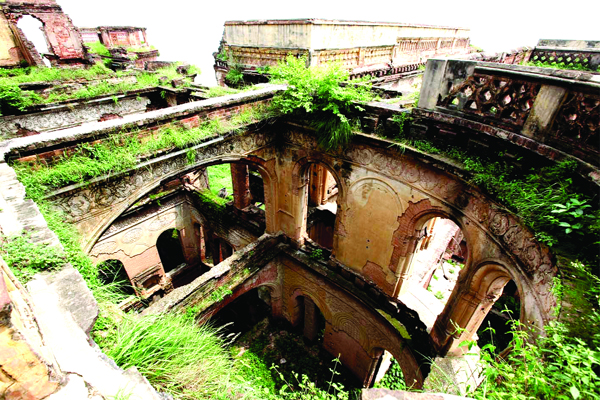Hemani Badyal
A broader understanding for cultural heritage has been developed in the last few months in Jammu region, with heightened recognition for the need of heritage conservation. As the state government is working with a mandate to promote both tangible and intangible culture heritage, it has emerged as an important stakeholder in the conservation and safeguarding of the cultural heritage of the state in all its diverse manifestations. New projects and strategies are being excogitated to create new assets in the culture and tourism sector. However in response to this paradigm shift, a need is felt to ensure effective measures and management plans for the “protection, conservation and presentation of the cultural and natural heritage”, especially in the context of growing altercations with urbanity.
The fundamental question that arises is “which heritage is important”, “to whom”, “why” and “how” it should be conserved. Apart from the political parties, the role of the private individuals and institutions is also of paramount importance in the conservation process as they serve as testaments to the diverse cultural expressions and practices in the region. Thus linking heritage conservation to the living traditions will give the cultural heritage a function in the life of the community. There is a need to address the various challenges ranging from better interpretation of heritage sites, it’s appropriate use or adaptation, use of appropriate conservation techniques and materials, the manner in which the process and the final product contributes to the surrounding environment and the local community’s cultural and historic continuum. Thus, to overcome these challenges a profound understanding of conservation as a social process is required. This process will foster community involvement and capacity-building, and will have a catalytic effect on local restoration and conservation efforts.
Mubarak Mandi Palace Complex is one of the most important built heritages of the Jammu region. Its restoration has been ongoing since 2008 without any directives and implementation of a conservation management plan for the development of the historic precinct. The project methodology adopted and being practiced at present for the conservation of the historical palace complex is limited to the consolidation of the built structures alone and not returning back the buildings which are culturally significant as part of an urban ensemble, to the local community. Developing an understanding of the true spirit of the place and reflecting this understanding in the conservation process, is central to the mission of the sustainable development of heritage sites. Due to the lack of harmonization between the tangible and intangible cultural values, Mubarak Mandi has lost its significance, leaving only an empty shell behind. The sense of associational value acquired through use is being lost eventually because the restoration process being followed is not time bound and lacks management of the heritage site. The government has recently announced that the work on the execution of Mubarak Mandi Ropeway Project shall be expedited. But the argument here is that what purpose the Ropeway will serve if the Palace Complex lies obsolete. Seeing the appropriate use and values of the historic complex being negotiated, it becomes important to re-visit the fundamental questions of “which heritage is important”, “to whom”, “why” and “how” it should be conserved.
Heritage has been created by and for the people. The priority should be first to strengthen understanding of the Living Heritage concept and to promote a Living Heritage approach in the Mubarak Mandi Palace Complex. Living Heritage has been characterized by ICCROM as a concept of “continuity”; in particular the continuity of a heritage site’s original function or ‘the purpose for which they were originally intended’ and the continuity of community connections (continuity of a core community). The living heritage approach, if practiced at Mubarak Mandi Palace complex, will help in conserving its past and integrating the evolving needs of the people in a manner that accrues social and economic benefits for its future. In this way, it is expected that it will increase awareness and sensitivity towards heritage; encourage the use of local resources and strengthen efforts to retain and promote local craft traditions; and promote the continuity of the function (use).
At Mubarak Mandi Palace complex, a careful evaluation of its historical and cultural values is necessary to determine the elements that contribute to the site’s significance. An appropriate Conservation Management Plan needs to be developed for Mubarak Mandi which will work in tandem with these assessed values and condition assessments of the built structures (which have already been prepared by INTACH). This will in turn help finalizing the phasing and priority of conservation/art works in the Palace Complex and framing the plans in coherence with guidelines and policies outlined by the Management Plan. Subsequently, secondary plans, namely the Interpretation and Use Plan, Environment Management Plan, Lighting and Risk Management Plan and Universal Accessibility Plan shall be executed at the site.
A selection of appropriate functions for the site which allows for continued use of the resource without compromising with the cultural significance of the site is essential. Instead of making Green Field investments in construction of new Heritage Museums or Cultural Parks, efforts should be made to upgrade the existing Dogra Art gallery and the Diwan-e-aam which can serve as a good Public Space for the people of Jammu. Successful conservation of our built heritage lies in reusing and adapting older buildings to modern standards and requirements with minimal interventions. This will not only save the physical fabric of the building, but will also ensure the socio-economic viability and relevance in the near future. The role of public-private partnership also becomes important in the stewardship of the cultural heritage sites as it can benefit in funding, directing and implementing heritage conservation. All this will automatically trigger the ‘Living’ dimension at the heritage site of Mubarak Mandi, thus making it timeless.
(The author is a Conservation Architect hailing from Jammu.)
Trending Now
E-Paper


